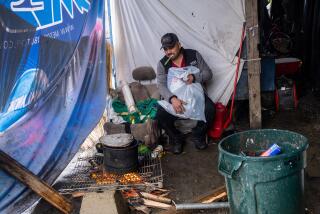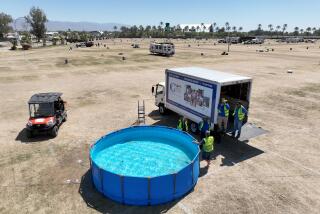Route 66 Marks Several Paths Through City
L.A. loves fakes. Fake lips. Fake breasts. Fake names (Ice Cube, Ice T, Mr. T).
This is, after all, the entertainment capital of the world. It’s all about faking it.
A reader wondered if Los Angeles’ propensity to put up a false front extends to Route 66, the historic “mother road” from Chicago to Los Angeles. The road, though no longer an officially designated route, has been celebrated in books (“The Grapes of Wrath”), song (“Get Your Kicks on Route 66”) and a TV series (“Route 66”).
Alex Smith of Los Angeles wrote to Behind the Wheel to point out that his map book shows several routes, including a few that parallel each other, all claiming the Route 66 title.
Question: How can there be two or more Route 66s running parallel so close?
Answer: There are several roads with that designation because the route had several alignments over its 80 years or so of official existence.
For example, three roads from South Pasadena to downtown Los Angeles -- Figueroa Street, Huntington Drive and the Pasadena Freeway -- all bear the historic Route 66 signs.
Here is how it happened: In 1926, Route 66 ran west along Colorado Boulevard, south along Fair Oaks Avenue, then southwest along Huntington Drive, eventually ending in downtown Los Angeles, said Dan Harlow, a board member of the California Route 66 Museum in Victorville.
In 1937, state and federal officials moved Route 66 to Figueroa Street, a wider, more accessible road with a more direct route to Santa Monica and the ocean. When the Arroyo Seco Parkway (also known as the Pasadena Freeway) opened in 1940, government officials once again realigned the route, giving the parkway the Route 66 designation, Harlow said.
While the route was moved several times, historians and road buffs have lobbied to put up the historic designations -- the Route 66 signs -- to memorialize the past routes.
Still confused? Think of it this way: Last year, Motor Trend magazine named the Chrysler PT Cruiser as “Car of the Year.” This year, the title may go to a snazzier model with better acceleration, plusher seats or more headroom. In Los Angeles, it seems the Route 66 designation has simply been transferred over time to the newer, snazzier road.
Make sense?
*
Morbid curiosity. It’s that odious human trait that makes motorists slow down and stare at the sight of a car accident or a police stop on the side of the road.
Statistics from the California Department of Transportation show that rubbernecking alone can reduce freeway speed by as much as 26%.
Patty Boyle of Westchester wrote to point out that, a few years ago, Caltrans built several areas on the side of Los Angeles freeways that are shielded from traffic by 6-foot-high fences. The sites were designed so that motorists stopped by police or involved in minor accidents could pull behind the fences, thus giving looky-loos nothing to looky at.
Q: Do you know if the (accident investigation sites) are actually used and, if so, what their effectiveness has been?
A: Caltrans built 12 of these sites on the Harbor, San Diego and Santa Monica freeways in the early 1990s. Caltrans officials say the sites are used often, but the state has not completed any studies to confirm this.
Still, such a study may be moot. Caltrans officials say they have built no more accident investigation sites because they have simply run out of available freeway real estate. Whatever excess freeway space is available is now being swallowed up to add carpool lanes.
*
Speaking of getting an eyeful on the road, Deane Bottorf of Corona del Mar wrote to recount a frightening experience on a city street. While cruising around recently, he saw what looked like an unoccupied car pull up alongside him. Bottorf eventually discovered that the driver of the car was sitting so low in the seat that he could barely peer over the top of the dashboard.
Q: Is it illegal?
A: Unfortunately, Bottorf’s experience is not unique. CHP Officer Alex Delgadillo said lots of drivers in Southern California think it is hip or cool to sink really low in the seat while driving.
It’s called lowriding and it has been around for decades. Remember the 1970s tune by the band War? “The low rider drives a little slower
It may be bad posture, and your mother may not approve, but it is not illegal to slouch while driving. “It has come up in the past, but there is nothing we can do,” Delgadillo said.
*
Patrick Clark of Azusa wrote to say that he gets steamed when he sees so many out-of-state license plates on Southern California freeways. He wants these newcomers to do the right thing and register those cars. (Hey, our debt-ridden state can use the fees.)
Q: I realize that there are a lot more important concerns for the Highway Patrol, but I was just wondering if anything is ever done about this?
A: State law requires a motorist to register for a California license plate within 20 days of accepting employment or establishing residence in California. But this violation does not get high-priority enforcement.
CHP officers do not stop motorists with out-of-state plates solely to make sure they are abiding by this law. If a CHP officer stops a motorist for another offense, such as speeding, and notices the out-of-state plates, then the officer can investigate and write a citation.
Concerned folks like Patrick also can tip off the CHP or the Department of Motor Vehicles if they know of such a scofflaw in the neighborhood.
But as long as these newcomers to the state stay on good terms with police and neighbors, they can drive around for a while without registering.
Maybe what California needs is a statewide campaign. We can post billboards at the state borders that read: “Welcome to California. Now Register Your Car.”
*
If you have a question, gripe or story idea about driving in Southern California, send an e-mail to behindthewheel@latimes.com.
More to Read
Start your day right
Sign up for Essential California for news, features and recommendations from the L.A. Times and beyond in your inbox six days a week.
You may occasionally receive promotional content from the Los Angeles Times.







